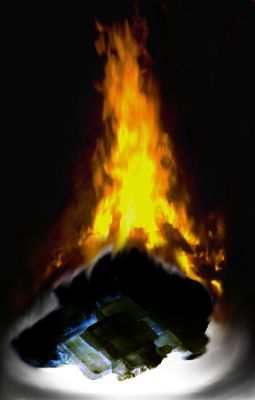by Larry
September, 2006A Dicey Disaster - Underground Coal FiresThe fires in China alone every year burn through perhaps as much as 120,000,000 tons of coal, nearly as much as the total production of our major coal industry states of PA, OH, and IL combined. The China fires also add 360 million tons of carbon dioxide to the air annually, equal to the entire volume of such pollution added by US cars and light trucks. Globally, the underground coal fire problem or its effects augment substantially the pollution burden placed on the atmosphere, significantly lower the amount of sunlight reaching the earth's surface (reducing crop yields), cause immense health problems, undermine or force the evacuation of whole communities, further the extent of agricultural or forest destruction from acid rain, poison waterways, and, of course, waste vast amounts of natural resources.
In both China and India there are enormous underground super-fires, hundreds or even thousands of miles in extent. They and other coal fires in additional Asian nations are a principal cause of the two- to three-mile thick layers of soot in that part of the world, which may at times stretch from Sri Lanka to Afghanistan.
While the scope of the disaster is most apparent in Asia, the US is not immune to the underground fire scourge. According to "Smithsonian" magazine, for example, underground fires in PA vent poisonous gases into the air above them, cause the surface to be too hot in places for safe walking, and result in holes opening up that can swallow cars or houses. The overall effect is to create a "hellish landscape," virtually uninhabitable. Real estate values plummet in such an environment, of course, but that is one of the least of former residents' difficulties. Under one such community, Centralia, PA, now all but abandoned, the coal fires have already been burning for over 40 years. Unchecked, they could burn another two to three hundred years. There is plenty of nearby coal left. Many of the former miners of the area lost their livelihood when the fires made further work underground impossible. Then most lost their homes as well once the above ground environment had become too inhospitable. The fires have occasionally been ignited by volcanic or lightning causes, but they were started primarily by human interventions, for example through mining activities or, in at least one instance, burning garbage in a landfill established right on top of an exposed coal seam. Unfortunately, once well underway, these fires are terribly hard to extinguish. Scientists say, though, that efforts must be made to put many of them out, even if with difficulty and expense. They argue that we may have less than another decade to get greenhouse gas pollution under more reasonable control before we enter a phase of "runaway global warming." Curtailing the carbon dioxide added from coal fires will need to be among the corrective actions if we are to succeed in time with that effort. The biggest danger is that global temperature changes will be fed by an unstoppable feedback loop of both warming and increasing greenhouse gases, as from melting icecaps and permafrost, exposing more and more dark surfaces, which absorb greater amounts of the sun's heat, that releases greater quantities of methane from decaying peat, burning forests, etc., after which the planet's average temperature would rise several degrees, with regional increases of ten degrees F or more. According to "National Wildlife" magazine, few yet realize how close we have come to this catastrophic scenario and how small a remaining window of opportunity we may now have before unquenchably hot climates, with even year round summers in formerly temperate areas, become possible in the not so distant future. Methods for putting out underground fires that have been used with some effectiveness include completely filling in the mines involved, inundating them with water, or dumping in foam-like substances which expand in the shafts, thus cutting off the fires' oxygen. These approaches, though, may not be practical for the largest fires. Most coal fires are permitted to burn indefinitely, until, sometimes generations or centuries later, they finally have consumed all their available coal supplies. |
